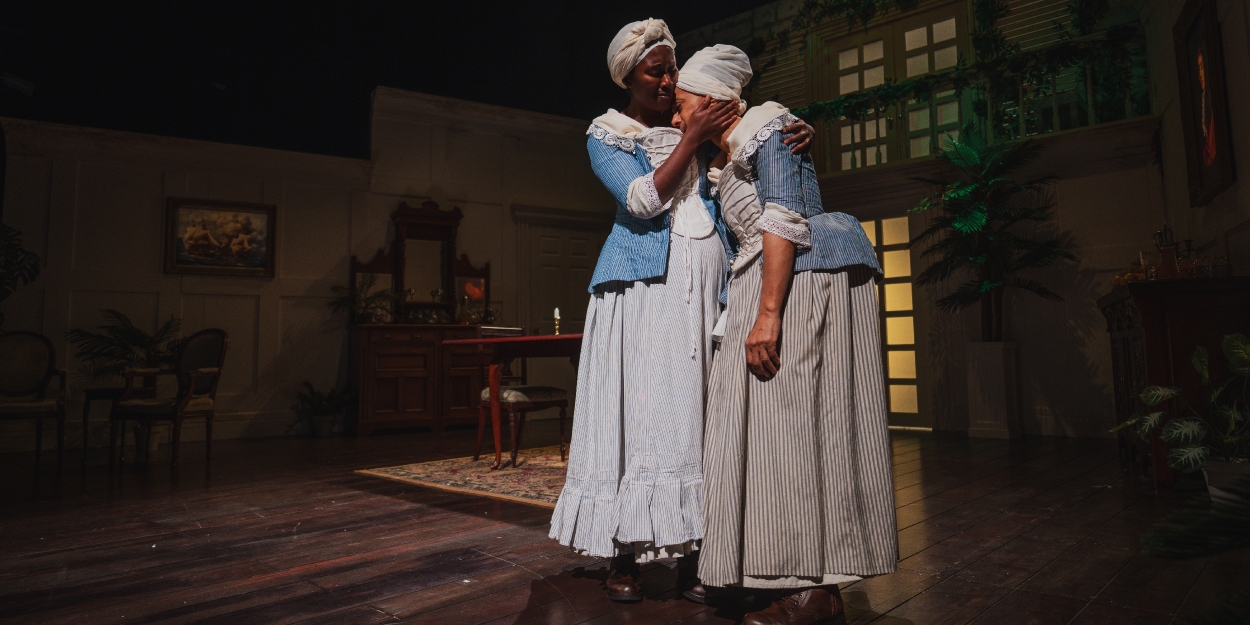Review: THE WOMEN OF LLANRUMNEY, Stratford East
Azuka Oforka’s powerful debut play - a tense, heart-wrenching exploration of the slave trade - transfers to London.

![]() When a Welsh slave owner risks losing her plantation, Annie knows things could get much worse for her and Cerys. Still, she endlessly sings the praises of the household, boasting about how they’re the best dressed slaves in the parish: It’s a privilege and an honour to work for the Morgans (yes, the rum ones).
When a Welsh slave owner risks losing her plantation, Annie knows things could get much worse for her and Cerys. Still, she endlessly sings the praises of the household, boasting about how they’re the best dressed slaves in the parish: It’s a privilege and an honour to work for the Morgans (yes, the rum ones).
Annie’s loyalty, however, is a ploy: “The closer you are to white people, the closer you are to freedom.” Cerys couldn’t see it more differently. To her, freedom needs to be conquered, not granted, so she tells her alleged mother of the revolution that’s just about to break, of the army that the rebels are rising to fight their masters. It almost earns her a slap or two, but Annie’s reaction to her brave, bold contempt is priceless.
Azuka Oforka’s powerful debut play transports us to the Llanrumney sugar estate in Saint Mary Parish, Jamaica, in 1765, where Elizabeth Morgan (Nia Roberts) lays the law as an unwed modern entrepreneur who’s facing the failure of her crops. All of a sudden, the threat to their survival exacerbates her house maids' battle of self-preservation and heart-wrenching compromise. Coming straight from a starry sell-out run at the Sherman Theatre in Cardiff, The Women of Llanrumney is a layered exploration of tyranny, endurance, and unflinching female defiance directed by Patricia Logue.
%20Chuko%20Cribb%20(3).jpg)
Elizabeth is the product of colonial high society. Debauched and fake, she retells her shenanigans the encouraging and supportive Annie, who thinks of herself as her Best Friend and confidante, serving her an inordinate amount of food (that will go to waste) in the same breath as Elizbeth judges her hosts for doing the same the night before. Oforka nimbly toys with these complex contradictions throughout in a very expressive, descriptive text.
Where Roberts and her gaudy gowns command the walls of her house, Suzanne Packer (Annie) and Shvorne Marks (Cerys) exchange glances - one of reprimand, the other of disdain. As Annie speaks of humans selling and buying other humans like she’s commenting on the weather, putting ideas in her owner’s mind that rely on too much faith in their crooked relationship, Packer introduces a woman who’s had to bend in order not to be broken. What could be perceived as selfish individualism and delusion in another context is unyielding hope that kindness will change her life.
%20Shvorne%20Marks%20and%20Suzanne%20Packer%20in%20The%20Women%20of%20Llanrumney%20at%20Stratford%20East%20(c)%20Chuko%20Cribb%20(2).jpg)
On the other side, Marks is passionate and heartful as Cerys. Unlike Annie, Cerys was forced to work the fields since she was four years old, relentlessly punished for her lack of speed. Annie tells her of the brutal treatment she’s seen, of the women tortured and left for dead for no reason, Cerys experienced it firsthand. In a harrowing moment, the action stops and Oforka takes a beat to paint a lifelike, high-resolution picture of slavery. It’s one of the many shockingly uncomfortable sequences (all justified and serving the plot).
Joining the trio of women is Matthew Gravelle as the series of horrible men who deal with Elizabeth. His role perfectly shows how, in spite of her class, Elizabeth counts for nothing because she is still a woman in a solid patriarchy. Annie had to rewire her brain to accommodate a cruel world, knowing her place in a precarious balance, Elizabeth never came to realise her own subjugation. “You owned me [...] last night I owned you” Gravelle says as Tommy Flynn, Elizabeth’s former Irish servant who made his fortune as a slave trader. It’s difficult to watch. The power dynamics keep being spun, then turned upside down.
%20Nia%20Roberts%20and%20Matthew%20Gravelle%20in%20The%20Women%20of%20Llanrumney%20at%20Stratford%20East%20(c)%20Chuko%20Cribb.jpg)
Shunned from society, Elizabeth experiences a colossal fall from grace, briefly getting a small taste of the moral compromises that her slaves had to grapple with all along. She remains, however, ruthless. “I did more for you than for my own children!” Annie cries. Set against designer Stella-Jane Odoemelam’s two-floor antebellum house, the production is continuously heart wrenching. The visuals work with intention to represent the delicate precarity between Oforka's layers of meaning. This knotty and tense play packs a punch.
The Women of Llanrumney runs at Stratford East until 12 April.
Photo Credits: Chuko Cribb
Reader Reviews

Videos
